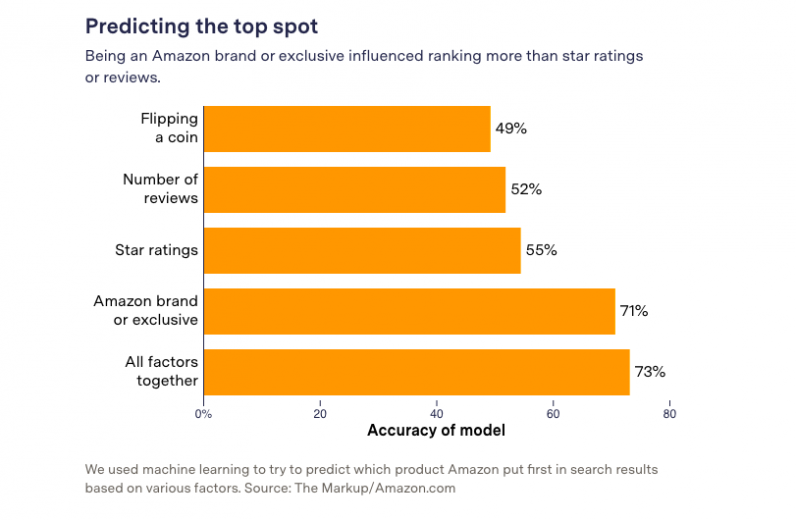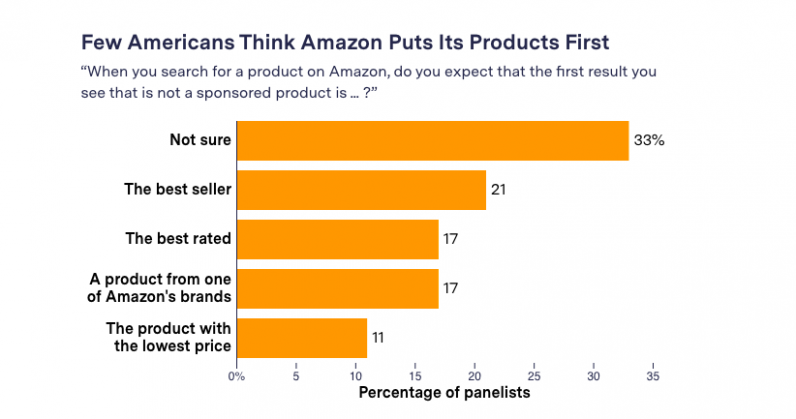It took Robert Gomez about five months to get his Kaffe coffee grinder to the big leagues in e-commerce: among the first three search results for “coffee grinder” on Amazon.com.
Gomez, founder of Atlanta-based consumer goods startup 4Q Brands, said he obsessively refined his photos and description, amassed reviews from happy customers, and paid Amazon $40,000 a month on advertising to boost sales, one of the elements Amazon tells sellers will increase search ranking.


Then Amazon introduced a competitor from house brand Amazon Basics and another from a brand that sells exclusively on Amazon, DR Mills.
“They ranked well right away,” Gomez said, each of them appearing among the top-three results for “coffee grinder” searches immediately. The reason, he said, was clear: “Their search ranking is high because they’re an Amazon brand.”
An investigation by The Markup found that Amazon places products from its house brands and products exclusive to the site ahead of those from competitors—even competitors with higher customer ratings and more sales, judging from the volume of reviews.
We found that knowing only whether a product was an Amazon brand or exclusive could predict in seven out of every 10 cases whether Amazon would place it first in search results. These listings are not visibly marked as “sponsored” and they are part of a grid that Amazon identifies as “search results” in the site’s source code. (We only analyzed products in that grid, ignoring modules that are strictly for advertising.)


When we analyzed star ratings and number of reviews, neither could predict much better than a coin toss which product Amazon placed first in search results.
Amazon told Congress in 2019 that its search results do not take into account whether a product is an Amazon-owned brand.
Sellers say it doesn’t seem that way to them. Gomez said Amazon’s brands have “unfair advantages” that make it harder for small merchants like him to compete” on its open marketplace. “Who bears the cost are those entrepreneurs and small businesses that don’t have the means to fight.”
The Markup found Amazon placed its Happy Belly Cinnamon Crunch cereal, with four stars and 1,010 reviews, in the number one spot ahead of cereals with better and more reviews including Cap’n Crunch (five stars, 14,069 reviews), Honey Bunches of Oats (five stars, 5,205 reviews), and Honey Nut Cheerios (five stars, 11,702 reviews). A vacuum cleaner from Amazon’s exclusive Noisz brand was placed on top, ahead of models from Bissell, Eureka, and Hoover with higher ratings and more reviews. And the Amazon-exclusive Concept 3sneaker from Skechers placed number one, four spots ahead of a similar but not exclusive to Amazon Skechers sneaker with the same star rating but 77 times more reviews.
A former Amazon employee told The Markup that the company used to give its new house brand products an unearned place at the top of search rankings when they first launched. He said the practice has since stopped.
However, we found that Amazon brands and exclusive products overall received an outsized portion of the top spot on search results, one that was far out of line with their proportion of the sample.
That’s not what shoppers expect.


In a national survey we commissioned from YouGov, only 17 percent of respondents said they assumed Amazon put its own products first. Half said they expected the first non-sponsored product on Amazon’s search results page to be the cheapest, highest rated, or bestselling.
By giving its brands top billing, Amazon is giving itself a significant leg up in sales. The first three items on the search results page get 64 percent of clicks, according to one ex-Amazon-employee-turned-consultant.
In a short, written statement, Amazon spokesperson Nell Rona said that the company does not favor its brands in search results and declined to answer any of the dozens of specific questions posed by The Markup.
She said the company identified its brands to shoppers by adding “Amazon brand” to the list of product features on the product page and sometimes to the listing title as well. We only found this to be the case in 23 percent of products in our sample that were Amazon-owned brands. She said brands that are exclusive to Amazon would not carry the disclosure because they are not owned by the company.
Invisible tags
A signal, invisible to the public but coded into the listings, suggests that most of the Amazon brand and exclusive products that were listed first were ads. In 87 percent of cases, the listing’s source code identified them as “sponsored”—though that label isn’t shown to the public. Instead, Amazon labels the products “featured from our brands.”
Rona, the Amazon spokesperson, said the company considers “featured from our brands” listings “merchandising placements” and not “search results,” despite their presence in the search results grid. She also said they are not ads, despite the “sponsored” label in the source code. Rona said they are “clearly labeled to distinguish them from search results” but did not respond to questions about whether the company believes such disclosures were clear enough under Federal Trade Commission requirements.
Mary Engle, who retired as the FTC advertising practices associate director last year, said that what Amazon calls “merchandising” is actually advertising.
“Amazon’s placement of its own products on its own site is advertising, whether or not money changes hands,” she said. She said it would require an investigation to determine whether “featured from our brands” is sufficient disclosure under the FTC’s rules.
Bill Baer, a former assistant attorney general in charge of the antitrust division of the U.S. Department of Justice and former director of the Bureau of Competition at the FTC, said if consumers expect Amazon’s product search results to be neutral, but they are not, and the site is essentially a monopoly, that could be a violation of the FTC Act of 1914, which prohibits unfair competition and unfair or deceptive practices in commerce, or the U.S. Sherman Antitrust Act, which prohibits monopolies from using their market power to harm competition.
“If basically you’ve got somebody with market power that is restraining competition both in terms of site access or where things appear on the site,” he said, “that is potentially problematic.”
Amazon’s online marketplace garners more than five times more sales than its closest online competitor, Walmart, which also allows third-party sales.
Congress is considering a package of anti-monopoly bills aimed at big tech, including the Ending Platform Monopolies Act, which would make the practice of platforms giving their brands a leg up explicitly illegal.
Amazon refers to its own brands and brands developed by others that sell exclusively on Amazon as “our brands.” They peddle everything from snack chips and vitamins to fashion and furniture.
Using public records from the U.S. Patent and Trademark Office and Amazon’s own statements, we identified more than 150 brands registered by or owned by Amazon. These include both brands with an obvious connection, such as Amazon Basics and Amazon Commercial, and those that are generally known to be owned by the company, including Kindle and Zappos. But they also include dozens more, such as Happy Belly, Daily Ritual, and Society New York, where the connection to the company is not obvious. Those are in addition to the estimated hundreds of third-party brands that are exclusive to the site.
We analyzed search results on Amazon for 3,492 popular internet product queries in January 2021 and looked closely at what Amazon placed in the first spot. In 60 percent of cases, Amazon sold this spot to an advertiser and added a public label indicating the listing was “sponsored.” Of the rest, Amazon gave half to its own brands and brands exclusive to the site, and the other half to competing brands. But Amazon brands and exclusives made up only 6 percent of all products in the sample, and competitors made up 77 percent. In short, Amazon was hogging the top spot.
In more than a quarter of searches in which Amazon gave its brands the top spot, it placed its products above competitors that had both better ratings and more reviews than the Amazon brand or exclusive product.
‘They would shut us down’
Sellers said there’s no mistaking the effect on sales of Amazon’s choices in search results.
“If the customers are not seeing [our products] in the top five offers, then it makes it really hard for us to reach customers,” said Gabriela Mekler, a Miami mom who co-founded the organizational products company Mumi in 2014.
Mumi’s top product—a set of color-coded packing cubes—struggles for visibility on Amazon, even after more than two years on the site. She said the coronavirus pandemic decimated her sales—they dropped by more than 68 percent—costing the company a hard-won “Amazon’s Choice” badge on its packing cubes.
Mumi has not been placed on the first page of our search results for “packing cubes” for months. At the time of this writing, Amazon Basics took up eight spots on the first page; one was labeled “featured from our brands.” None were visibly marked “sponsored.”
“Their product will always show before yours,” Mekler said.
One Mumi product has still been selling well despite the pandemic, she said: reusable pill pouches. For now, there is no Amazon Basics pill pouch, and Mekler hopes there won’t be anytime soon.
“We’re a small company,” she said. “They would shut us down.”
Some annotated examples of popular searches we collected in January 2021. Source: The Markup / Amazon
The National Association of Wholesaler-Distributors, which represents more than 30,000 distributors, submitted a letter to members of Congress in July 2020, complaining that Amazon “abuses its position” to give preferential treatment to its house brands.
But when The Markup asked to speak to some of the sellers the group had quoted anonymously, NAW’s vice president of government relations, Blake Adami, demurred.
“Our members are still very hesitant to speak out against Amazon for fear of retaliation,” he said in an email, “even anonymously.”
Many sellers whose products we found were placed below Amazon products with fewer sales or ratings also declined a reporter’s request to be interviewed for this article, saying they were concerned it would negatively affect their livelihoods.
“Everybody’s so scared of Amazon,” said Paul Rafelson, executive director of the Online Merchants Guild, which represents Amazon sellers. “Their whole livelihood relies on them.”
‘This was a knockoff’
Some of Amazon’s competitors have accused the company of knocking off their products to sell under its house brands.
Williams Sonoma settled a lawsuit that included the claim that Amazon was copying West Elm furniture and selling it under the Amazon house brand Rivet. Allbirds co-CEO Joey Zwillinger wrote an open letter to Jeff Bezos when Amazon’s 206 Collective brand copied his company’s wool sneaker, urging Amazon to adopt Allbirds’ sustainability practices in addition to its design.
In March, Amazon Basics started selling the Everyday Sling, a camera bag with a similar design, the same name but a much lower price than a product from Peak Design.
“It wasn’t like they took some styling cues from it. This was a knockoff,” CEO Peter Dering said in an interview. The smaller company produced a parody video that now has 4.6 million views on YouTube. Within hours, Amazon changed the product’s name.
Dering said he wasn’t worried about losing sales because Peak Design mainly targets wholesalers and customers who want a high-end brand. Still, he said he found the move “highly distasteful.”
Rona, the Amazon spokesperson, said the company “did not infringe” on Allbirds’ or Peak Design’s “design rights” and “strictly prohibit[s] our employees from using nonpublic, seller-specific data to determine which store brand products to launch.”
Hard to spot
Identifying all of Amazon’s brands and brand exclusives to the site for this investigation was cumbersome. The company does not provide a complete list. The Markup’s reporting team used various filters on the site, reviewed the U.S. Patent and Trademark Office records, and reviewed Amazon bestseller lists—but even then we likely missed some.
Consumers would have an even harder time. We found Amazon does not consistently label its brands and exclusives.
Of the products in our sample that Amazon considered “our brands,” about two in five were not labeled as such in search results nor did they carry a name that many people would understand was connected to the company, such as Amazon Basics, Kindle, or Whole Foods.
Inconsistent labeling, combined with an almost endless stream of its own private brands, leaves customers in the dark to decide whether Amazon highly ranked a particular product because it was a good buy or because it benefited the company’s bottom line.
Nine in 10 respondents to the national survey The Markup commissioned in July didn’t know that Amazon’s highest-selling house brands, apart from Amazon Basics, were owned by the company.
Even there, 24 percent of respondents could not identify Amazon Basics as an Amazon brand, and half didn’t know Amazon owned Whole Foods.
To test your knowledge, Select all products from Amazon brands and exclusives: link
Alex Harman, competition policy advocate at Public Citizen who has studied Amazon’s marketplace, said that to him, the strategy of creating a stream of brands without a clear affiliation to Amazon feels “deceptive.”
Large brick-and-mortar retailers also have house brands. Costco has Kirkland Signature. Target has Up&Up, among others. Historically, he said, when large stores create brands they have been clearly affiliated with the store.
And Amazon’s search results are different from a store shelf.
“Unlike a retail store where you see everything on the shelf, the platform may be in a position to elevate its goods in a way that is harder to do in a retail outlet,” said Baer, the former FTC official, and assistant attorney general at the Justice Department.
By creating more than a hundred trademarked brands, most without an obvious connection to the company, Amazon can preserve its reputation if one of its homegrown products flops. This happened in 2015 when customer reviews for its newly launched Amazon Elements diapers included complaints about leaks and “sagginess.” Amazon pulled the products after just seven weeks to make “design improvements.”
Stacy Mitchell, co-director of the small business advocacy group Institute for Local Self-Reliance, and a frequent Amazon critic, said that as Amazon’s brands squeeze competitors, those competitors have less money to spend on innovation—and consumers lose.
“Consumers don’t even know what’s missing,” she said.
Case in point: Brandon Fuhrmann, who runs the New York Amazon Seller Meetup. He was considering expanding his kitchenware brand into a new type of dishware. While checking trademark registrations and U.S. import logs for sellers with similar products, he realized that the majority of his competition would come from Amazon brands.
“When that happened, we realized we couldn’t even compete,” he said. He decided not to launch the product.
Rise of Amazon brands
Amazon has continually set its sights on dizzying growth.
It launched in 1995, with the goal of becoming “Earth’s Biggest Bookstore.” Four years later, it declared its intention to become “Earth’s Biggest Selection.”
It’s nearly there: People now spend more money on Amazon than at Walmart, making it the world’s largest retail seller outside of China.
To reach this point, it took a page from rival eBay’s playbook, inviting individuals and business owners to list rare, used, and collectible items—which quickly transitioned to third parties selling mainstream, new wares on Amazon.
In 2003, Jason Boyce got a call from Amazon asking him to list his company’s basketball products on the nascent marketplace.


“We’re like, what are you talking about? You guys sell books,” he said. “What do you mean you’re selling sporting goods?”
Boyce took the plunge and his company’s basketball sales took off on Amazon.
By 2018, third-party sellers like Boyce were responsible for 58 percent of physical goods sales on Amazon. They helped boost Amazon’s North American sales by more than an order of magnitude, from $24.5 billion in 2009 to $386.1 billion in 2018.
The volume created fortunes for small businesses across the world. It also created a deep reliance on Amazon. A 2021 report by JungleScout, which provides software for Amazon sellers, found that Amazon was the only source of income for 22 percent of Amazon’s third-party sellers.
“Within two years of getting on Amazon, most of my clients, whether they want to or not, it becomes their single biggest sales channel,” said James Thomson, who was a manager at Amazon from 2007 to 2012 and now works at the e-commerce consulting firm Buy Box Experts.
And these new third-party sellers had lots of competition, eventually from Amazon itself.
Boyce said Amazon started undercutting his business, selling the same sporting goods—Spalding basketballs, for example—for less.
Unable to compete with Amazon on price for brand-name products, Boyce and his brothers launched their own brand, Harvil, in 2007, to sell sporting goods and home recreation equipment on Amazon. They figured Amazon couldn’t undercut their prices if he and his brothers owned the brand.
They had no idea Amazon was also beginning to launch its own brands and to enter into deals with companies to develop brands exclusive to the platform.
Among the first Amazon brands was Pinzon (a likely nod to the first conquistador to stumble across the Amazon River), which Amazon registered as a trademark in 2007 to sell bedding. Then came Denali for tools, and Amazon Basics for a slew of products, including household appliances and office supplies.
Sometime in 2017, Boyce was searching keywords related to his products on Amazon—”bocce ball,” “air hockey table”—when he noticed a new brand, Rally and Roar, peddling very similar products to his own. They showed up at the top of search results.
Rally and Roar are exclusive to Amazon, labeled as “our brands.” The company was moving in on his territory, again.
The speed of Amazon’s expansion of its own brands has been accelerating, according to several e-commerce and retail research firms. TJI Research counted 598 Amazon-exclusive brands in 2019. Coresight Research said Amazon brand products on the site tripled in the two years between 2018 and 2020 alone.
Amazon invites companies and individuals to join its “our brands” family through programs like Amazon Accelerator, which promises increased exposure for products sold exclusively on Amazon in exchange for extra fees, and sets a sales price if Amazon chooses to later buy the brand.
Boyce and his brothers had already been talking about getting off Amazon’s platform when they noticed Rally and Roar pop up. That settled it.
“We’re like, we’re not going to sit around and wait for Amazon to knock off the rest of our private-label products as well,” he said.
They sold the business.
A leg up
For years, Amazon gave items from its own brands multiple advantages when they first launched, said JT Meng, a former house brand manager at Amazon—though he said the practice has since stopped.
Employees manually applied the Amazon’s Choice label to a new Amazon brand product, even if it didn’t meet the usual criteria, he said.
And instead of starting from scratch in search results with zero reviews, sales, and stars, Meng said employees used a tactic called “search seeding” for new products, “cloning” a competing product’s search ranking and allowing the new Amazon product to appear immediately below that competitor in search results.
“We would use that for all of our products from the get-go for the first six months or longer,” he said.
Meng worked on the launch for Amazon Elements baby wipes, which he said were seeded against similar products from Huggies, Pampers, and others.
Sales spiked so quickly that his team had to stop promoting the Amazon Elements wipes so they didn’t take too much market share, he said.
Once a new house brand product was established, Meng said employees would turn off search seeding. “Without fail, your product would drop in ranking,” he said, “but the hope was that it would drop a small amount.”
By the time Meng left Amazon in 2016, he said search seeding and adding the Amazon’s Choice label to new Amazon brand products were no longer allowed.
Sellers who do try to compete with Amazon brands today said they feel compelled to pay for sponsored listings in order to get a higher result for non-sponsored listings on Amazon. On its Seller Central site, Amazon underlines to sellers how important sales are, stating that “better-selling products tend to list towards the beginning of search” and that as sales increase “so does your placement.”
“You can’t not advertise anymore,” said Boyce, who after selling his sporting goods line founded a consulting firm, Avenue7Media, which advises companies and individuals who want to sell on Amazon.
“You turn off the ads and you lose organic rank within days,” Boyce said. “It’s pay to play.”
Lots of companies are paying.
We found that inside the search results alone, 17 percent of products were paid listings. That doesn’t include entire rows of sponsored products that appear as special modules on about a third of search result pages. (Including those would roughly double the ad percentage on the first results page.)
Amazon is the third-largest seller of online advertising in the U.S., after Google and Facebook, and is growing fast. “Other” revenue, which the company says “primarily includes sales of advertising services,” jumped 52 percent from 2019 to 2020, to $21.4 billion a year.
Struggling for visibility
“If you’re willing to spend a ton of money, you can sell a ton of product,” said Evan Patterson, vice president of business development at California-based Linco, which is one of Boyce’s clients.
The 47-year-old family-owned institution makes casters, the small wheels that attach to office chairs and industrial gear—and has a solid reputation in the offline world for premium products. It competes against a product from Amazon Commercial, among others.
It’s so well known in industrial circles that Linco’s competitors advertise against its name within Amazon’s search results, Patterson said.
Still, Linco hasn’t consistently listed on the first page of search results for “caster wheels,” despite selling on Amazon for years. It will appear on the first page for Patterson, but did not in repeated searches by The Markup.
The only thing that seems to help Linco’s search ranking, Patterson said, is to spend more money for paid listings on Amazon. The company now pays about $10,000 a month for advertising.
“Our search ranking has improved dramatically,” Patterson said.
But it still has a ways to go. When The Markup searched for “caster wheels” at the time of writing, Linco appeared in the middle of the fifth page.
This article was originally published on The Markup by Adrianne Jeffries and Leon Yin and was republished under the Creative Commons Attribution-NonCommercial-NoDerivatives license.